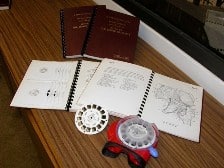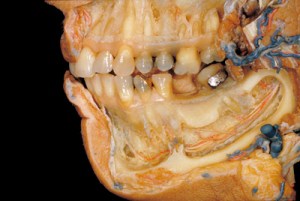 Visitors to the John Martin Rare Book Room are often bemused when they spot a View-Master resting on one of the bookcases. If you’re under the age of sixty-five you probably owned one of these devices along with several View-Master reels depicting far-off countries, cartoon characters or comic book heroes rendered in 3-D. But why a viewer in the rare book room? In 1962, Dr. David L. Bassett, anatomist from the University of Washington, working with William Gruber, the inventor of the View-Master created the “Stereoscopic Atlas of Human Anatomy” — over 1,500 slides of three-dimensional color images of human dissection. Nearly fifty years later the 25 volume collection remains a marvel of relatively simple technology that still elicits gasps of wonder from viewers as they behold in stark clarity the “in-depth” photographs of body structures and cavities. Each of the slides is accompanied by commentary written by Dr. Bassett (the lone dissector) and a line diagram that labels all of the structures.
Visitors to the John Martin Rare Book Room are often bemused when they spot a View-Master resting on one of the bookcases. If you’re under the age of sixty-five you probably owned one of these devices along with several View-Master reels depicting far-off countries, cartoon characters or comic book heroes rendered in 3-D. But why a viewer in the rare book room? In 1962, Dr. David L. Bassett, anatomist from the University of Washington, working with William Gruber, the inventor of the View-Master created the “Stereoscopic Atlas of Human Anatomy” — over 1,500 slides of three-dimensional color images of human dissection. Nearly fifty years later the 25 volume collection remains a marvel of relatively simple technology that still elicits gasps of wonder from viewers as they behold in stark clarity the “in-depth” photographs of body structures and cavities. Each of the slides is accompanied by commentary written by Dr. Bassett (the lone dissector) and a line diagram that labels all of the structures.  The Hardin Library is fortunate to own a complete set of this amazing work which is beginning to arouse the curiosity of anatomists interested in using high-tech solutions to bring 3-D to desktop computers. In the meantime the marvelous handiwork of Mr. Gruber and Dr. Bassett is at your disposal.
The Hardin Library is fortunate to own a complete set of this amazing work which is beginning to arouse the curiosity of anatomists interested in using high-tech solutions to bring 3-D to desktop computers. In the meantime the marvelous handiwork of Mr. Gruber and Dr. Bassett is at your disposal.
You can read about and view more images of Dr. Bassett’s work here.